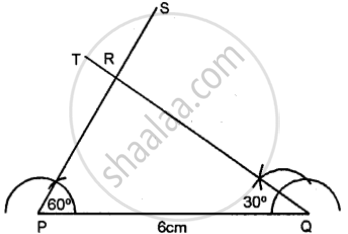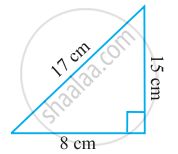Advertisements
Advertisements
प्रश्न
Construct a triangle PQR, given PQ = 6 cm, ∠P = 60° and ∠Q = 30°. Measure angle R and the length of PR.
उत्तर
Steps of Construction:
(1) Draw a line PQ = 6 cm.

(2) Using compass taking P as centre draw an angle ∠P = 60°.
(3) Using compass taking Q as a centre draw an angle ∠Q = 30°.
(4) PS and QT intersect each other R. (5) ∆RPQ is the required triangle.
On measuring; ∠R = 90°, length of PR = 3 cm.
APPEARS IN
संबंधित प्रश्न
Construct traingle ABC, when : AB = 6 cm, BC = 8 cm and AC = 4 cm.
Construct traingle ABC, when : AB = 5.4 cm, ∠A = 30° and ∠B = 90°. Measure ∠C and side BC.
In the following figure, triangle ABC is equilateral and triangle PBC is isosceles. If PBA = 20°; find angle BPC.
Construct a triangle ABC given AB = 6 cm, BC = 5 cm and CA = 5.6 cm. From vertex A draw a perpendicular on to side BC. Measure the length of this perpendicular.
Using ruler and a pair compass only, construct a triangle PQR, given PQ = 5.5 cm, QR = 7.5 cm and RP = 6 cm. Draw the bisectors of the interior angles at P, Q and R. Do these bisectors meet at the same point ?
Find the value of x if ∠A = 32°, ∠B = 55° and obtuse angle AED = 115°.
Name the type of following triangle :
∆PQR such that PQ = QR = PR = 5 cm.
Name the following triangle in two different ways: (you may judge the nature of the angle by observation)

Draw a rough sketch of a regular hexagon. Connecting any three of its vertices, draw a triangle. Identify the type of the triangle you have drawn.
A diagonal is a line segment that joins any two vertices of the polygon and is not a side of the polygon. Draw a rough sketch of a pentagon and draw its diagonals.
